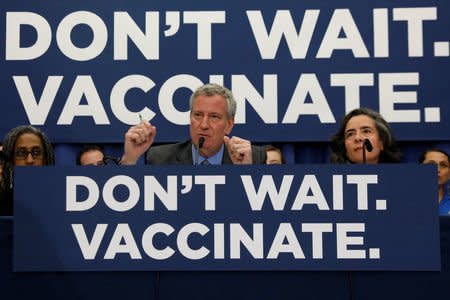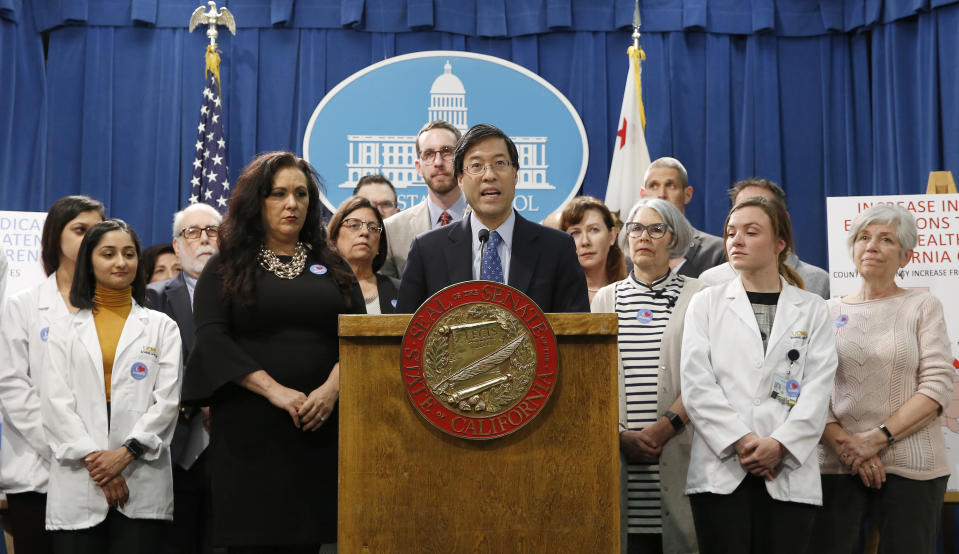Anti-vaxxers are costing Americans billions each year
New data from the Centers for Disease Control (CDC) has found that measles outbreaks (defined as 3 or more cases) have hit their second-highest level since the country eliminated the disease in 2000. The highest reported number of measles cases since elimination was 667 in 2014.
And research has shown that vaccine-preventable diseases among adults, like measles, cost the U.S. nearly $9 billion per year. Unvaccinated individuals, in particular, drive most of that cost.
As of April 4, the CDC reports there have been 465 confirmed measles cases spread across 19 states, including New York, New Jersey, Connecticut, California, Oregon, Georgia, Texas, Nevada, and Kentucky. This week New York City declared a public health emergency as measles spread in Brooklyn, mandating measles vaccinations in certain zip codes.
“We are delusional if we believe that an outbreak in a limited county in Northwest New York doesn’t have very rapidly national implications, if not international implications,” Kathleen Sebelius, former Secretary of Health and Human Services, told Yahoo Finance said. “There are very few boundaries anymore, and very few limitations.”
“You put people on a plane, and you have in a short time a global crisis,” she added, speaking about measles. “The ramifications are mind boggling. And how fast this could become a very dangerous outbreak given how contagious it is — is very troubling.”

Measles cases have been on the rise, the CDC says, thanks in part to an increase of infected travelers who bring the disease into the United States, where they infect unvaccinated populations. There has also been an uptick in children whose parents choose to forego immunizations for contagious, and often, deadly diseases.
Last year, the CDC reported that there was a small but notable rise in vaccination exemption rates for infants and school-aged children. Many parents have recently refused to immunize their children against diseases like the measles for fear that the vaccine could cause autism.
A costly burden
In the past decade, there has been a measles outbreak each year, resulting in 2,423 cases — and counting. In 2013, the CDC estimated that the cost of hospitalization for measles was between $4,032 and $46,060 per person. At the low end, this would mean that since 2010, roughly $9.7 million was spent on treating measles. At the high end, the cost balloons to $111.6 million.
And measles isn’t the only preventable disease burdening the health care system. According to a 2015 study from UNC’s Eshelman School of Pharmacy, “vaccine-preventable diseases among adults cost the U.S. economy $8.95 billion — and unvaccinated individuals are responsible for 80%, or $7.1 billion, of the tab.” The report highlights that the biggest money drag is the flu (influenza), costing some $5.8 billion in 2015 alone. Pneumococcal disease and herpes zoster (which causes shingles) are the next two most costly vaccine-preventable diseases with price tags of $1.8 billion and $782 million, respectively.
But Sachiko Ozawa, the study’s author and Associate Professor at UNC Eshelman School of Pharmacy, says that in reality, the number is even higher. Her report only looked at adults, and didn’t consider children — or societal costs in the long run.
“We looked at short-term burden, because we weren’t able to put a value on the elderly that may be suffering more because they aren’t actually in the workforce,” she said. “But if we were to value those elderly and even go back to children, there would be more burden to examine.”

Increasing costs
In the most recent flu season for which data was available (2017-2018), the CDC reported 49 million flu-related cases, which resulted in 960,000 hospital visits and 79,000 deaths. This is a large leap from the 2016-2017 flu season when the country was hit with 30 million flu-related cases. The year before that, there were 25 million flu cases, indicating that the flu is on the rise.
A 2007 report found that the economic burden of the flu was a jaw-dropping $87.1 billion, with direct medical costs accounting for just under $10.5 billion and $16.3 billion in lost earnings. When Yahoo Finance analyzed pneumococcal incidents in 2016 of people of all age ranges and applied the CDC’s costs of hospitalization, the range was a staggering $111.5 million-$759.4 million. In total, for just these two diseases, the economic cost stands at roughly $90 billion.
When dealing with public health crises, Ozawa says, “there are also opportunity costs associated” and that the “burden quickly multiplies”.
And that has social ramifications, Sebelius says.
“There’s an incredible private-sector cost from employment and productivity of an employee that takes a ding,” she said. “And I think there is no shortage of the fear effect. If you’re in a community and suddenly you read in your neighborhood or city there is an outbreak, do you stop going to public parks? Do you not choose to take your family to the movies? Which has a financial impact on those vendors.”
Measuring impact
The bulk of immunized Americans who vaccinated their children are also impacted in indirect ways.
“The U.S. health care system is facing significant losses in dealing with the negative consequences of treatment for high-cost diseases vs. prevention with low-cost vaccines,” said William Padula, Assistant Professor of Pharmaceutical and Health Economics in the School of Pharmacy at the University of Southern California. “These losses have downstream consequences in other areas,” he added.

Padula says that emergent infectious diseases disrupt budgetary planning for health care providers. Insurance companies allocate a certain amount of money, he said, for different diseases and conditions. But in order to treat these preventable diseases, money that might have been allocated to other conditions — like cancer or heart disease — must be reallocated to treating the infectious disease.
“$7 billion spread among 350 million people isn’t so bad,” he said, referring to Ozawa’s research. “You might not even notice if premiums go up $1 or $2. But if it’s 30% to 50% of the population, that could have an impact. We are paying for infectious diseases that were never factored into budgets.”
Padula also imagines that this could negatively impact employer based healthcare plans.
“Imagine a company that supports a community,” he said, “like a factory that makes screws in Central Ohio. And that factory that has 350 employees has the bandwidth to pay for insurance for employees. Now if an outbreak breaks out in that town, that company could go bankrupt.”
“You could see the more immediate issue of impacting businesses that provide health insurance. That’s the short-term model. In the long term premiums can increase,” Padula said.
Return on investment
The cost of preventing disease is far more cost effective than treating it, Ozawa and Padula say.
“We looked at the return of investment of child preventable diseases,” Ozawa said. “We found that the ‘ROI’ for every dollar invested was around $16. Using another methodology, we found it was more like 44 times.”
“The fact that people are getting sick from things they can avert, and are [paying these] costs themselves — or that the insurance companies and health care systems are paying costs that can be averted is the part that worries me the most. As a public health professional we are about averting things that can be averted and keeping people healthy,” she said.

“I’ve never seen an economic or public health paper where the cost benefit of vaccines were outweighed by not being vaccinated,” said Padula.
Sebelius said that the strains of treating these preventable diseases is made worse given all the public health cuts that have been made.
“Public health is one of the poorest funding sources in government,” she said. “Public health is very easy to cut — it’s an easy target at the federal level.”
In the latest Trump budget, the administration proposed slashing over $750 million from the CDC, and close to $1 billion from HHS programs.
The anti-vax threat
According to Sebelius, the anti-vaccination movement is “absolutely” a “significant threat” to public health.
“It’s clearly a step back, if we are dealing with a measles outbreak that was essentially eliminated two decades ago,” she said. “And it’s a self-inflicted step back.”
She called for policy makers to consider the price we are “willing to pay” when these diseases can carry such large human and financial tolls.
“Over time very limited exemptions [to vaccination] have been greatly broadened, and I think that’s the issue that policy makers have a responsibility to look at again,” Sebelius said.
Padula, who travels to other countries to discuss vaccines with other communities reflects on the difference between communities abroad and here at home. “How is it that I’m traveling to Uganda and Ghana and India and they’re loving making the choice of immunization and I’m watching my own country regress backwards in time getting infected with diseases we haven’t seen in 50 years?”
“It’s really perverse.”
Kristin Myers is a reporter at Yahoo Finance. Follow her on Twitter.
Read more:
NRA could ‘shut down forever,’ group warns in fundraising letter
RNC and Trump campaign money are pouring into Trump businesses
Follow Yahoo Finance on Twitter, Facebook, Instagram, Flipboard, LinkedIn, YouTube, and reddit.
